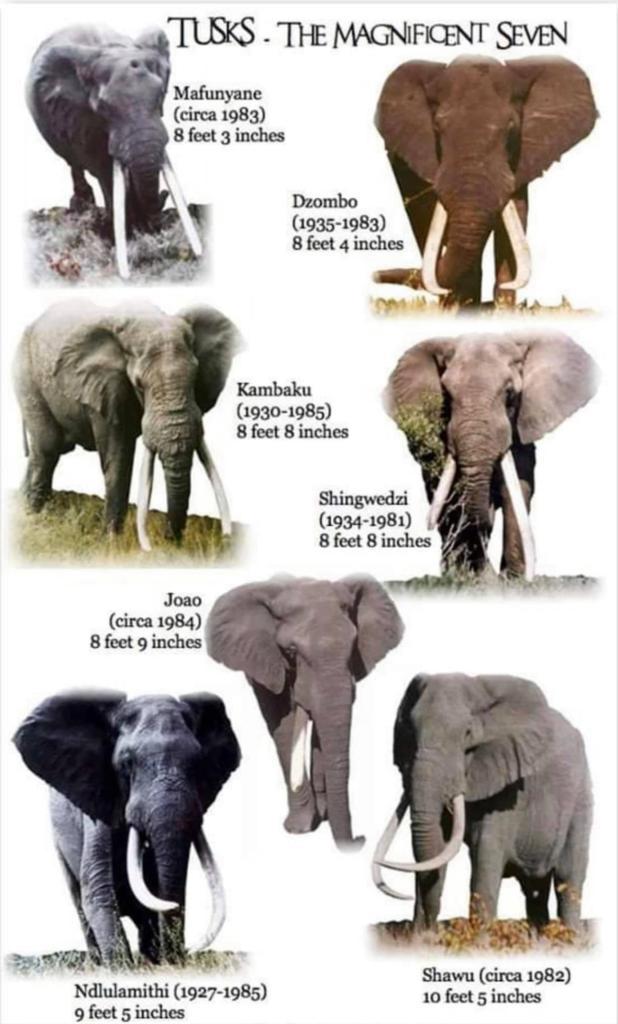The Magnificent 7 were a group of elephants that lived in the Kruger Park that were known to have the largest tusks of any Elephants.
Dzombo
Dzombo was named after the river that flows across the Mopani flats between the Shawu and Shingwedzi valleys. He lived in the Shawu valley bounded by the three rivers, Lethaba, Shingwedzi and Tsendze. Dzombo’s tusks were the classic shape of African elephants, curved upwards and slightly forwards, and were almost identical in weight, thickness and depth. Dzombo was the only one of the Magnificent 7 to have his life ended by poachers. At the age of 50, Dzombo was gunned down by miscreants using AK-47’s and were in the process of retrieving the tusks when they were disturbed by game wardens.
João
João received his name from Anthony Hall, who did the naming for Prester John, the legendary Priest King. João is a portuguese name that means ‘John’. João could be found at the waterhole that bore his name, along the Shingwedzi River. João was a very large bull that had a shoulder height of 340cm and spent a lot of time in an area south of the Shingwedzi river.
João was injured by poachers in 1982 and had to be immobilized so the wardens could treat his injuries. Luckily João wasn’t fatally injured and they just gave him a dosage of antibiotics and a radio collar so he could be tracked if anything happened. At the age of 45, João was the largest ivory carrier alive. Unfortunately João broke both his tusks near the tip after an encounter with another bull. He is the only member of the Magnificent 7 that isn’t in the Elephant Hall Museum.
Kambaku
Kambaku got his name from a Tsonga word meaning ‘Great Tusker’. Kambaku travelled huge stretches of land from stretching from Satara/Orpen and Timbavati to Crocodile Bridge. Kambaku was a very unique Tusker. He had a round hole in his ear close to the outer edge and had a distinct marking in his trunk in the form of a smooth patch of skin. Close to the end of his life, Kambaku had no tail hairs. Kambaku was the third of the Magnificent 7 and was usually seen close to Kingfisherspruit and was photographed by a lot of people. Kambaku was the only member of the Magnificent 7 that was seen alone.
Kambaku was shot in 1985 (he was 55 years old) by Park Rangers. He was in pain from a bullet wound in his shoulder that he suffered during an ambush at the Crocodile River. The bullet penetrated his shoulder and left a gaping hole that got septic. Kambaku was in a lot of pain and was unable to walk after a while and the wardens decided to Mercy kill Kambaku.
Mafunyani
Mafunyani was named after Park Ranger Lou Steyn who was famous for his quick temper, In Tsonga Mafunyani means the Irritable one, which was rather clear since he couldn’t stand humans. Mafunyani moved and lived in the area in the upper reaches of the Shingwedzi River and to the bottom of the Bububu River. Mafunyani’s tusks were very unique in the fact that they were perfectly symmetrical, with the same length, weight and thickness. His Tusks were relatively sharp because it kept rubbing against the ground as he walked. His tusks straighter than normal and didn’t curve upwards.
When Mafunyani was immobilised by Game Wardens on 8 June 1983 to fit a radio collar and to make plaster casings of his tusks, disaster struck. After the antidote was applied for the immobilization, Mafunyani was unable to get onto its chest (which would have helped him to get up) and as he rocked and rocked, his tusks dug deeper into the soil. After various attempts, wardens used a front loader to lift Mafunyani.
Ndlulamithi
Ndlulamithi is a Tsonga word meaning ‘Taller than the trees’. This makes it the perfect name for this great tusker as it perfectly described his appearance. Ndlulamithi had a large area that he roamed that included the area around the main road, from the Phongol River to the Byashishi Drainage System. Ndlulamithi’s tusks were beautifully curved, with the left one sweeping low and more forwards. His Tusks were much more curved than other animals. Ndlulamithi was considered a tall elephant with his shoulder height being around 345cm.
Ndlulamithi was a very aggressive yet secretive elephant that was first spotted at the Nkokodzi River in 1980 and was very seldom seen. This elephant is famous for charging at Dr. Anthony Hall-Martin while he was busy photographing the Tusker on foot.
Shawu
Shawu was given his nabe because he spent most of his life in the Shawu Valley. Shawu lived in a rather large area between the Letaba and Shingwedzi rivers. Shawu didn’t travel this enormous area on a regular bases but moved rather slowly. Shawu’s tusks were the longest in the Kruger Park and the 6th longest in Africa. Shawu was not particularly affected by cars or vehicles and was actually fairly approachable. Shawu was a rather large bull that was 340cm at shoulder height. The Shape of Shawu’s tusks were pointed towards each other in a pincer shape. In Afrikaans he was referred to as ‘Groot Haaktand’. Shawu died at the amazing age of 60 years.
Shingwedzi
Shingwedzi got his name from the Shingwedzi river and the Rest camp where he spent the last years of his life. Shingwedzi means ‘Place of Ironstone’ which refers to the rock outcrops in the area. Shingwedzi loved travelling, usually known to travel between Shingwedzi and the Chugamila Hills. Shingwedzi’s tusks showed a perfect example of Master – Servant formation, with his left tusk shorter than his right tusk. Shingwedzi was found dead under a Fig tree close to the Shingwedzi Rest Camp. It seemed like he died of natural causes and wardens estimate that he was about 56 years old.
Though these great Tuskers have all passed away, you can get a glimpse of some of the future Tuskers when you book a Kruger Park Game Drive with Kambaku River Lodge

